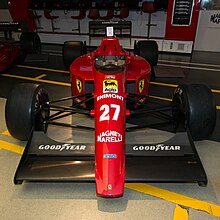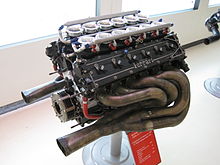Ferrari 640
|
Ferrari 640 |
|||||||||
| Constructor: |
|
||||||||
| Designer: |
|
||||||||
| Predecessor: | Ferrari F1-87 / 88C | ||||||||
| Successor: | Ferrari 641 | ||||||||
| Technical specifications | |||||||||
|---|---|---|---|---|---|---|---|---|---|
| Chassis: | Monocoque | ||||||||
| Engine: | Ferrari 035/5, 65 ° V12 engine, 3.5 liters | ||||||||
| Length: | 4400 mm | ||||||||
| Width: | 2130 mm | ||||||||
| Height: | 950 mm | ||||||||
| Wheelbase: | 2830 mm | ||||||||
| Weight: | 505 kg | ||||||||
| Tires: | Goodyear | ||||||||
| Petrol: | Agip , 102 octane | ||||||||
| statistics | |||||||||
| Driver: |
|
||||||||
| First start: | 1989 Brazilian Grand Prix | ||||||||
| Last start: | 1989 Australian Grand Prix | ||||||||
|
|||||||||
| World Cup points: | 59 | ||||||||
| Podiums: | 9 | ||||||||
| Leadership laps: | 127 over 570.007 km | ||||||||
| Status: 1989 | |||||||||
The Ferrari 640 was a Formula 1 racing car that Scuderia Ferrari used in the 1989 Formula 1 World Championship .
Development history and technology
The Ferrari 640 was developed by John Barnard . The 640 was the result of an extensive test program, with a test car, the Ferrari 639, already being extensively tested in mid- 1988 . The 640 is largely based on this car. In addition, the new engine was tested in a converted Ferrari 87/88, as the semi-automatic gearbox was used in the 639, which made effective engine testing very difficult due to its unreliability.
For the 1989 season, the turbo engines used in previous years were banned and replaced by naturally aspirated engines with a displacement of 3.5 liters. Ferrari then developed a 12-cylinder engine with five valves per cylinder, which at the end of the season produced around 600 hp at 12,500 rpm.
Ferrari was the first Formula 1 team to use a semi-automatic seven-speed gearbox which, like the clutch, was electronically controlled via valves. This saves time on winding roads compared to a racing car operated with a conventional gearbox. A clutch pedal was still there, but was only used for moving off in first gear.
The situation was completely new for both drivers. Until now, racing cars had a small gearshift lever on the edge of the cockpit, which was used to change gear like a conventional car, but with the new semi-automatic transmission there were now small paddles behind the steering wheel (the right paddle for upshifting, the left paddle for downshifting) as they are standard in Formula 1 to this day. Gerhard Berger found this to be much more pleasant, whereas Nigel Mansell had difficulty adjusting, especially during the tests before the season. Nevertheless, he won his first Grand Prix with the car. After Mansell crossed the finish line, he was unable to get out. Two helpers had to help the winner out of the narrow cockpit, the Ferrari race director Cesare Fiorio massaged Mansell's left thigh for minutes. The inability to move was due to the fact that the leg "fell asleep", as Mansell hardly had to move it during the entire race.
The 640 was also a new development in terms of aerodynamics. Instead of making the side boxes wide and flat, they were made very high and thin. The width grew towards the middle of the vehicle before the side boxes converged again towards the rear. The vehicle's nose was significantly wider than before, which earned the car the nickname "duck". Ferrari also used an air scoop over the driver's head only after a delay, so that the roll bar was no longer visible during the season; In the first races of the season, the air inlets for the naturally aspirated engine were still attached to the left and right of the roll bar.
driver
After Berger moved to Ferrari in 1987 , it became apparent that Michele Alboreto would lose his number one position on the team. After a disappointing 1988 season, he was not given a new contract. For 1989 Mansell was committed, who moved from Williams to Scuderia.
Racing history

Despite the many innovations from Ferrari and an opening win from Nigel Mansell , both world championship titles were out of reach. The Ferrari 640 was a very fast, but also extremely unreliable car. Overall, there were more failures than finishings. Gerhard Berger was only able to finish the race three times out of 15 starts. However, if the car held out, Ferrari was a contender for victory. When the car reached the finish, it was never out of the top three places. Berger won a Grand Prix once when he crossed the finish line and was second twice.
After a serious accident in Imola , Berger had to pause for a race. Ferrari decided against using a third driver and entered the Monaco Grand Prix with just one car.
Nigel Mansell was disqualified twice during the season: At the start of the Canadian Grand Prix , after rain in the morning, the track was not yet completely dry at the start. Nevertheless, Mansell, Alessandro Nannini and Luis Pérez-Sala decided to head to the pit at the end of the introductory lap to have slicks fitted. Mansell and Nannini assumed they were at the bottom of the field when they accelerated out of the pit lane after changing tires. In reality they were at the front of the field because the start had been delayed slightly, which the two of them hadn't noticed. They were disqualified with the black flag. Pérez-Sala, whose tire change took a little longer, duly lined up at the end of the field and was therefore not penalized.
In Portugal , Mansell drove into the pit lane after the 39th lap, but failed to stop with his pit crew. When he noticed this mistake, he put the car in reverse and parked in front of his box, which was a clear violation of the rules. The race management consequently disqualified him. Mansell ignored this. While he was involved in a duel for second place with Ayrton Senna , the two collided and were eliminated. This put Alain Prost in second place behind Berger. After the race, Mansell protested that he had not seen the black flags, but was banned from the following race. Here too, Ferrari decided to compete with just one car.
The main problem of the Ferrari 640 was the susceptibility of the transmission to defects. Twelve of the failures were due to problems with this, and after his comeback in the Mexico race , up to and including the Silverstone race, Berger dropped out five times in a row for that reason alone. At the time of the breakdowns, however, the vehicles were usually on point or podium positions, which underlines the fundamental competitiveness of the type.
Results
| driver | No. | 1 | 2 | 3 | 4th | 5 | 6th | 7th | 8th | 9 | 10 | 11 | 12 | 13 | 14th | 15th | 16 | Points | rank |
|---|---|---|---|---|---|---|---|---|---|---|---|---|---|---|---|---|---|---|---|
| 1989 Formula 1 season |
|
|
|
|
|
|
|
|
|
|
|
|
|
|
|
|
59 | 3. | |
|
|
27 | 1 | DNF | DNF | DNF | DNF | DSQ | 2 | 2 | 3 | 1 | 3 | DNF | DSQ | EX | DNF | DNF | ||
|
|
28 | DNF | DNF | INJ | DNF | DNF | DNF | DNF | DNF | DNF | DNF | DNF | 2 | 1 | 2 | DNF | DNF | ||
| Legend | ||
|---|---|---|
| colour | abbreviation | meaning |
| gold | - | victory |
| silver | - | 2nd place |
| bronze | - | 3rd place |
| green | - | Placement in the points |
| blue | - | Classified outside the point ranks |
| violet | DNF | Race not finished (did not finish) |
| NC | not classified | |
| red | DNQ | did not qualify |
| DNPQ | failed in pre-qualification (did not pre-qualify) | |
| black | DSQ | disqualified |
| White | DNS | not at the start (did not start) |
| WD | withdrawn | |
| Light Blue | PO | only participated in the training (practiced only) |
| TD | Friday test driver | |
| without | DNP | did not participate in the training (did not practice) |
| INJ | injured or sick | |
| EX | excluded | |
| DNA | did not arrive | |
| C. | Race canceled | |
| no participation in the World Cup | ||
| other | P / bold | Pole position |
| SR / italic | Fastest race lap | |
| * | not at the finish, but counted due to the distance covered |
|
| () | Streak results | |
| underlined | Leader in the overall standings | |
literature
- David Hodges: Racing cars from A – Z after 1945. Motorbuch-Verlag Stuttgart, 1st edition 1994, ISBN 3-613-01477-7 .
Web links
Individual evidence
- ↑ ultimatecarpage.com Ferrari 640 (accessed May 21, 2015)
- ↑ Ferrari F1-89 (640) Grand Prix race. In: motorsportarchiv.de. Archived from the original on December 31, 2009 ; accessed on January 13, 2019 .



